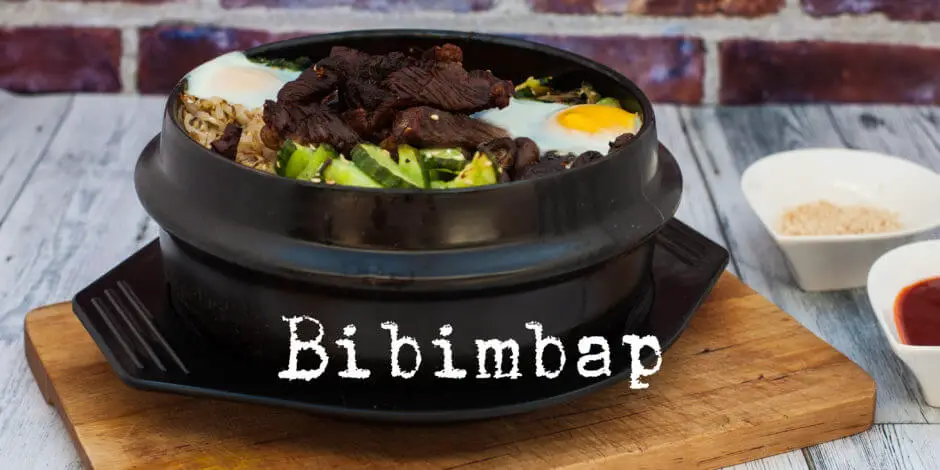I have been assured that this is an authentic bibimbap recipe, but it’s basically a dish made with leftovers that you have in your (Korean) refrigerator, so it can be made in 100 different ways. Many of the vegetable options that I make in this recipe and common, so you will get a good and varied dish.
New food inspiration is fantastic
A couple of years ago I was part of a very engaged community based around Yelp! We had a club called “Asian Sensation” which was basically about going out and enjoying fabulous Asian food. Yelp! shut down its activities in Denmark, but we are still a couple of people that go out together and eat (Asian) food together.
Three types of kimchi
One of the events stands out in my memory. One of the members invited us to try homemade Korean food, like the onet she grew up with. We had bibimbap with the works and a fried egg on the top, including three types of kimchi: the child version, the grownup version, and the “advanced” version.
The child version was made the same day, the grownup version had been fermenting for about a week, but the “advanced” version had been fermenting for months. Woah.
I’ve started making my own kimchi, and I make a version like the grownup version. I’ll post one to the blog here at some point.
I have to say that I found a new food crush that evening. It is Korean food.
Make it yourself?
Since then I’ve been introduced to some wonderful Korean restaurants, but I thought that time had come to try and make it myself. I ordered a dolsot bowl on eBay and waited (relatively) patiently for it to arrive.
It took a few months for it to arrive, but I wanted to make it the classic way. Honestly, it does not make a lot of difference when you eat it, whether you used a dolsot or a frying pan.
Only one special ingredient in this bibimbap recipe
Ad Links
The links for ingredients/items in this section are affiliate links,
which means I will get a commission if you purchase the product!
The only specialty ingredient I’ve used in this recipe is gochujang, which is a Korean fermented chili paste. I bought it in an Asian supermarket in Copenhagen, so you may find one in your local one. If not I left an amazon link above.
If you can’t get it, you can substitute it with sriracha. While it’s not authentic, it still tastes great.

No more babble. Here is my version of a Korean classic. I hope you will try my bibimbap recipe and that you enjoy it as much as we do here at home.
Please share on social media
This is my recipe for bibimbap. I hope you want to try it. If you make this recipe and post it on Instagram, please tag me as @foodgeek.dk so I can see it. That would make me very happy.

Bibimbap – Korean fried rice
Ingredients
Meat
- 500 gram steak (I used ribeye)
- 1 tablespoon soy sauce
- 1 tablespoon toasted sesame oil
- 1 tsp sugar
- ¼ tsp garlic, crushed
Vegetabels and stuff
- 250 gram baby spinach
- 350 gram bean sprouts
- 200 gram shiitake mushrooms (or button if you can’t get shitake)
- 200 gram carrots
- 250 gram rice (I used basmati)
- 1 spring onion (aka scallion)
- 4 cloves garlic
- 4 tablespoon sesame seeds
- 1 cucumber
- 1 zucchini (aka courgette)
- 4 eggs
Bibimbap sauce
- 2 tablespoon gochujang
- 1 tablespoon toasted sesame oil
- 1 tablespoon water
- 1 tablespoon sugar
- 1 tbp rice wine vinegar
To serve
- soy sauce
- kimchi
- toasted sesame seeds
Instructions
RIce
- If you already have some leftover rice, jump to the next section.
- Put 250 grams of rice and 375 grams of water into a pot with a good pinch of salt.
- Turn the up to full power until the water boils, then put a lid on, turn it down to low and let it simmer for 12 minutes.
- Take the pot off the heat and let it rest for 12 minutes with the lid on the pot. Then fluff the rice using a fork to separate the rice grains.
Prepare the vegetables and aromatics
- Cut the cucumber into slices. Place in a strainer over a bowl and sprinkle with salt. Leave to rest for 15 minutes.
- Cut the zucchini into slices. Place in a strainer over a bowl and sprinkle with salt. Leave to rest for 15 minutes.
- Finely chop the spring onion and put it in a small bowl.
- Peel four cloves of garlic and crush them into a small bowl.
- Cut the carrots into match sticks.
- Toast the sesame seeds on a dry roasting pan on medium heat. Toast until they are light brown and smell nutty. Put them in a small bowl to cool off
- Wring excess water out of the cucumbers add in to a bowl
- Mix the cucumbers with one teaspoon of chopped spring onion, half a teaspoon of crushed garlic, one teaspoon of sesame oil, and one teaspoon of toasted sesame seeds.
- Wring excess water out of the zucchini, add to a bowl.
- Mix the zucchini with one teaspoon of chopped spring onion, half a teaspoon of crushed garlic, one teaspoon of sesame oil, and one teaspoon of toasted sesame seeds.
Mariande the meat
- Make a marinade from soy sauce, sesame seed oil, sugar, and crushed garlic.
- Cut the meat into fine strips and add to a ziplock bag.
- Pour the marinade over, seal the bag and distribute the marinade well by massaging the bag.
- Put the bag in the refrigerator for at least 30 minutes, but longer is better.
Make the bibimbap sauce
- Combine gochujang, sesame oil, water, sugar, rice vinegar, crushed garlic, and one tablespoon of sesame seeds in a small bowl. Mix to combine.
- Leave the sauce on the kitchen counter until you are ready to serve.
Prepare the spinach
- Wash the spinach leaves thoroughly.
- Put water in a pot, add one teaspoon of salt, and heat to a rolling boil.
- Blanch the spinach for thirty seconds. Get the leaves out using a spider and turn off the heat. You'll need the water for the bean sprouts in the next section, so don't dump it.
- Wring the spinach leaves to get rid of excess water and put them in a bowl.
- Add one teaspoon of chopped spring onion, half a teaspoon of crushed garlic, and one teaspoon of toasted sesame seed and mix in using your hand.
Prepare the bean sprouts
- Heat the water again. When the water reaches a rolling boil, add the bean sprouts and leave them to boil for one to two minutes, depending on how much bite you'd like them to have.
- Drain the water and rinse them under running water.
- Shake to remove excess water and put a bowl
- Add one teaspoon of chopped spring onion, half a teaspoon of crushed garlic, a quarter teaspoon of fine sea salt, and one teaspoon of toasted sesame seeds, and mix with your hand.
Prepare carrots and mushrooms
- Fry the carrots in a hot pan in oil for two to three minutes. Add to a bowl and season with salt.
- If you use shitake mushrooms, cut off the stems since they don't taste good. Cut into fine slices.
- Sauté the mushrooms on the same pan, adding oil if needed—about two to three minutes.
- Add to a bowl and season with salt.
- Sauté the zucchini in the same pan for one to two minutes and add to a bowl.
Fry the meat
- Fry the meat in a scorching hot frying pan. Get a good crust on it and make sure it is a little less done than the way you like it. It is going to go in the oven later.
Assemble the dish
- You can use a Korean dolsot bowl or a cast-iron frying pan when you assemble the dish.
- Heat your oven to the maximum setting. Mine can go to 300°C (about 572°F) but go as warm as possible. If you have a pizza stone or baking steel, add that to the oven, as it retains heat. If you use a dolsot bowl, warm it with the oven, or it might crack.
- If you use a frying pan, you can heat it in the oven or stove.
- Take the bowl or frying pan out of the oven and put it on something that can withstand the heat. Turn the heat down to 260°C/500°F.
- Add some sesame oil to the bottom of the bowl. Then the rice. Stamp it using a large wooden spoon. The rice should sizzle when you put them in. We want those brown and toasted bits of rice in the dish.
- Arrange the vegetables and meat on top of the rice.
- Crack the eggs on top of the dish.
- Put the bowl back in the oven and prepare until the eggs are just how you like them. I want a runny yolk. It took about five minutes until mine was done. It's very oven dependent, so watch it every minute or so.
- Take out of the oven, pour some soy sauce in and mix it with two forks.
- Eat the dish while piping hot with extra toasted sesame seeds, kimchi, and a good dollop of bibimbap sauce.
- I hope it tastes great!










